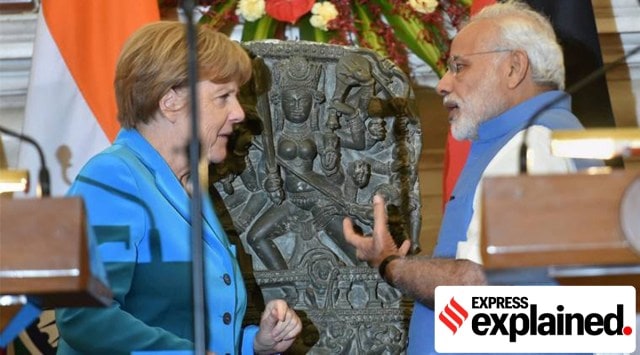
The Antiquities and Art Treasures Act, 1972, implemented on April 1, 1976, defined “antiquity” as “any coin, sculpture, painting, epigraph or other work of art or craftsmanship; any article, object or thing detached from a building or cave; any article, object or thing illustrative of science, art, crafts, literature, religion, customs, morals or politics in bygone ages; any article, object or thing of historical interest” that “has been in existence for not less than one hundred years.”
For “manuscript, record or other document which is of scientific, historical, literary or aesthetic value”, this duration is “not less than seventy-five years.”
What do international conventions say?
The UNESCO 1970 Convention on the Means of Prohibiting and Preventing the Illicit Import, Export and Transfer of Ownership of Cultural Property defined “cultural property” as the property designated by countries having “importance for archaeology, prehistory, history, literature, art or science.”
The Declaration further said that “the illicit import, export and transfer of ownership of cultural property is one of the main causes of the impoverishment of the cultural heritage of the countries of origin of such property and that international co-operation constitutes one of the most efficient means of protecting each country’s cultural property.”
After that, in 2000, the General Assembly of the UN and the UN Security Council in 2015 and 2016 also raised concerns on the issue. An INTERPOL report in 2019 said that almost 50 years after the UNESCO convention, “the illicit international traffic of cultural items and related offences is sadly increasingly prolific.”
What do Indian laws say?
In India, Item-67 of the Union List, Item-12 of the State List, and Item-40 of the Concurrent List of the Constitution deal with the country’s heritage.
Story continues below this ad
Before Independence, an Antiquities (Export Control) Act had been passed in April 1947 to ensure that “no antiquity could be exported without license.” In 1958, The Ancient Monuments and Archaeological Sites and Remains Act was enacted. Then in 1971, Parliament saw an uproar over the theft of a bronze idol from Chamba and some important sandstone idols from other places.
This, along with the UNESCO convention, prompted the government to enact The Antiquities and Art Treasures Act, 1972 (AATA), implemented from April 1, 1976.
The AATA states, “it shall not be lawful for any person, other than the Central Government or any authority or agency authorised by the Central Government in this behalf, to export any antiquity or art treasure… No person shall, himself or by any other person on his behalf, carry on the business of selling or offering to sell any antiquity except under and in accordance with the terms and conditions of a licence.”
This licence is granted by the Archaeological Survey of India (ASI). After the AATA was implemented, the Centre asked traders in antiquities and art objects to declare their possessions of antiquities by June 5, 1976, and individual owners by July 5, 1976.
What is ‘provenance’ of an antiquity?
Story continues below this ad
Provenance includes the list of all owners from the time the object left its maker’s possession to the time it was acquired by the current owner.
How is ownership proved?
The UNESCO 1970 declaration stated that, “The requesting Party shall furnish, at its expense, the documentation and other evidence necessary to establish its claim for recovery and return.” The first thing in order to prove the ownership is the complaint (FIR) filed with the police. In India, the problem with missing antiquities is that in many cases, there is no FIR. But other proof, like details mentioned by reputed scholars in research papers etc., also work.
How to check for fake antiquities?
Story continues below this ad
Under section 14(3) of the AATA, “Every person who owns, controls or is in possession of any antiquity” shall register such antiquity before the registering officer “and obtain a certificate in token of such registration.”
So far, the National Mission on Monuments and Antiquities, launched in March 2007, has registered 3.52 lakh antiquities among the 16.70 lakh it has documented, to help in “effective check” of illegal activities. This is a very small portion of the total number of antiquities in the country, which the government estimates to be around 58 lakh, according to a statement by the Ministry of Culture in Parliament in July 2022.
Can India bring back antiquities?
There are three categories to take note of: antiquities taken out of India pre-independence; those which were taken out since independence until March 1976, i.e. before the implementation of AATA; and antiquities taken out of the country since April 1976.
For items in the first two categories, requests have to be raised bilaterally or on international fora. For instance, the Maharashtra government on November 10, 2022 announced it was working to bring back the sword of Chhatrapati Shivaji Maharaj from London. This sword was given to Edward, the Prince of Wales (the later King Edward VII) by Shivaji IV in 1875-76. Several antiquities, from Vagdevi of Dhar (MP), to the Kohinoor diamond, to Amaravati marbles to the Sultanganj Buddha to antiquities related to Rani Laxmibai and Tipu Sultan, are currently abroad.
Story continues below this ad
Antiquities in the second and third categories can be retrieved easily by raising an issue bilaterally with proof of ownership and with the help of the UNESCO convention. The conviction of Subhash Kapoor has further given a chance to India to bring back smuggled antiquities.








































